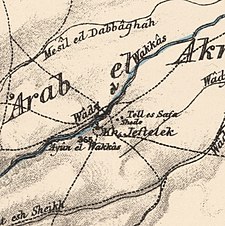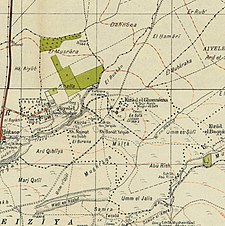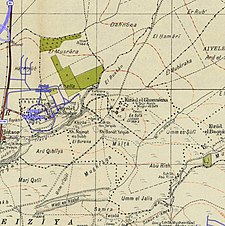Kirad al-Ghannama
Kirad al-Ghannama
كراد الغنامة | |
|---|---|
Village | |
A series of historical maps of the area around Kirad al-Ghannama (click the buttons) | |
Ayyelet ha-Shahar and Gadot |
Kirad al-Ghannama was a
History
By the
In the 1945 statistics, its population was 350 Muslims,[2] and the total land area were 3,975 dunams.[1] Of this, 77 dunams were for citrus and bananas, 20 dunams were irrigated or used for plantations, 3,451 for cereals,[5] while 64 dunams were classified as urban land.[6]
1948, aftermath

After the
In the spring of 1951, Israel decided to assert its sovereignty over the DMZ, including "the transfer of Arab civilians from the area.." On the night of the 30 March they forcibly transferred all the 800 inhabitants of Kirad al-Ghannama and Kirad al-Baqqara to Sha'ab.[9] A United Nations decision allowed the villagers to return, however, Israel pressured them to remain in Sha'ab. In spite of this, many of the villagers returned to their homes in the DMZ. In 1956 Israel expelled the two Khirad-villages again, and this time the sites were physically destroyed and ploughed over. Most of the villagers went to Syria, a few went back to Sha'ab.[10]
References
- ^ a b c Government of Palestine, Department of Statistics. Village Statistics, April, 1945. Quoted in Hadawi, 1970, p.70
- ^ a b Department of Statistics, 1945, p. 10
- ^ Morris, 2004, p. xvi, village #42. Also gives cause of depopulation. Morris notes that it was later resettled, followed by expulsion in 1956.
- ^ Mills, 1932, p. 106
- ^ Government of Palestine, Department of Statistics. Village Statistics, April, 1945. Quoted in Hadawi, 1970, p.119
- ^ Government of Palestine, Department of Statistics. Village Statistics, April, 1945. Quoted in Hadawi, 1970, p. 169
- ^ a b Morris, 2004, p. 512
- ^ UN Doc S/1353 Syria Israel Armistice Agreement of 20 July 1949
- ^ Morris, 1993, p. 362
- ^ Morris, 1993, p.362, citing Burns, E.L.M., p.115-118 and Summary of meeting with Prime Minister (of Israel) 4 July 1951.
Bibliography
- Burns, E.L.M. (1962). Between Arab and Israeli. George G. Harrap.
- Department of Statistics (1945). Village Statistics, April, 1945. Government of Palestine.
- Hadawi, S. (1970). Village Statistics of 1945: A Classification of Land and Area ownership in Palestine. Palestine Liberation Organization Research Center.
- ISBN 0-88728-224-5.
- Mills, E., ed. (1932). Census of Palestine 1931. Population of Villages, Towns and Administrative Areas. Jerusalem: Government of Palestine.
- ISBN 0-19-827850-0.
- ISBN 978-0-521-00967-6.
External links
- Welcome To Kirad al-Ghannama
- Kirad al-Ghannama, Villages of Palestine
- Kirad al-Ghannama, Zochrot
- Kirad al-Ghannama at Khalil Sakakini Cultural Center





